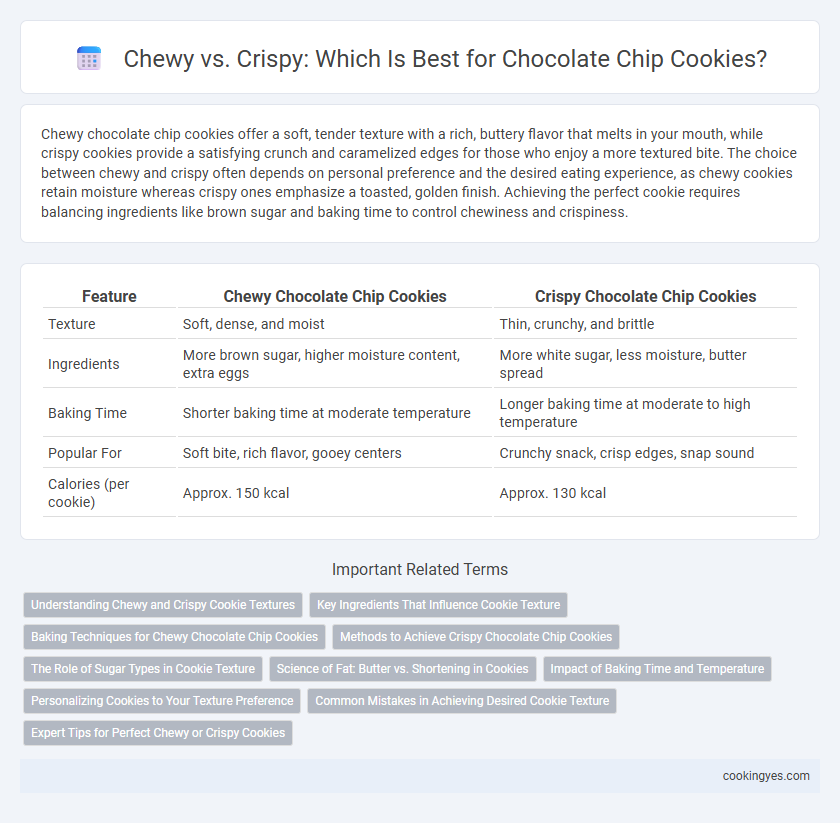Chewy chocolate chip cookies offer a soft, tender texture with a rich, buttery flavor that melts in your mouth, while crispy cookies provide a satisfying crunch and caramelized edges for those who enjoy a more textured bite. The choice between chewy and crispy often depends on personal preference and the desired eating experience, as chewy cookies retain moisture whereas crispy ones emphasize a toasted, golden finish. Achieving the perfect cookie requires balancing ingredients like brown sugar and baking time to control chewiness and crispiness.
Table of Comparison
| Feature | Chewy Chocolate Chip Cookies | Crispy Chocolate Chip Cookies |
|---|---|---|
| Texture | Soft, dense, and moist | Thin, crunchy, and brittle |
| Ingredients | More brown sugar, higher moisture content, extra eggs | More white sugar, less moisture, butter spread |
| Baking Time | Shorter baking time at moderate temperature | Longer baking time at moderate to high temperature |
| Popular For | Soft bite, rich flavor, gooey centers | Crunchy snack, crisp edges, snap sound |
| Calories (per cookie) | Approx. 150 kcal | Approx. 130 kcal |
Understanding Chewy and Crispy Cookie Textures
Chewy chocolate chip cookies have higher moisture content due to ingredients like brown sugar and melted butter, resulting in a soft, dense texture with a tender bite. Crispy cookies, on the other hand, use more granulated sugar and often bake longer at a lower temperature, creating a thinner, crunchy texture with a satisfying snap. Understanding the role of ingredient ratios and baking time is crucial for mastering the desired texture in chocolate chip cookies.
Key Ingredients That Influence Cookie Texture
Butter content and baking time are primary factors influencing whether chocolate chip cookies turn out chewy or crispy. Higher moisture content from butter and slightly underbaking creates a soft, chewy texture, while using more granulated sugar and longer baking times leads to a thinner, crispier cookie. The ratio of brown sugar to white sugar also plays a critical role, with brown sugar adding moisture and chewiness due to its molasses content.
Baking Techniques for Chewy Chocolate Chip Cookies
Achieving chewy chocolate chip cookies requires precise control over moisture and ingredient ratios, such as increasing brown sugar and shortening baking time to retain softness. Using melted butter and chilling the dough enhances gluten development and flavor while preventing excessive spreading during baking. Lower oven temperatures around 325degF (163degC) help maintain a tender texture and prevent crisp edges.
Methods to Achieve Crispy Chocolate Chip Cookies
To achieve crispy chocolate chip cookies, use a higher ratio of white sugar to brown sugar, as white sugar promotes crispiness by reducing moisture retention. Incorporate melted butter instead of softened butter to create a thinner dough that spreads evenly and crisps during baking. Bake at a slightly lower temperature for a longer time, around 325degF for 12-15 minutes, to allow the cookies to dry out and develop a crunchy texture.
The Role of Sugar Types in Cookie Texture
Brown sugar's higher moisture content contributes to a chewier chocolate chip cookie by retaining water during baking, while granulated sugar promotes crispness by encouraging spread and caramelization. The combination of sugars balances texture, with brown sugar enhancing softness and chewiness, and white sugar creating a firmer, crisper edge. Adjusting the ratio of brown to granulated sugar directly influences the cookie's final texture, catering to preferences for chewy or crispy chocolate chip cookies.
Science of Fat: Butter vs. Shortening in Cookies
Butter's water content promotes steam production during baking, contributing to a chewier chocolate chip cookie texture by creating moisture pockets. In contrast, shortening, which contains no water, yields a crispier cookie by preventing steam formation and promoting spread without additional moisture. The fat's melting point also affects cookie texture; butter melts at a lower temperature than shortening, enabling cookies to retain a softer, chewy interior.
Impact of Baking Time and Temperature
Baking time and temperature critically influence the texture of chocolate chip cookies, with shorter baking times at moderate temperatures producing chewy centers due to retained moisture. Higher temperatures and longer baking times cause more moisture to evaporate, resulting in crispy edges and a firmer cookie overall. Adjusting these variables allows bakers to achieve the preferred balance between chewiness and crispiness in chocolate chip cookies.
Personalizing Cookies to Your Texture Preference
Chewy chocolate chip cookies offer a soft, moist texture with a rich, gooey center, ideal for those who enjoy a tender bite. Crispy cookies provide a crunchy, golden exterior with a satisfying snap, perfect for fans of a more textured treat. Personalizing cookies to your texture preference involves adjusting baking time and ingredient ratios, such as using more brown sugar for chewiness or increasing baking soda for crispiness.
Common Mistakes in Achieving Desired Cookie Texture
Common mistakes in achieving the desired chewy versus crispy chocolate chip cookie texture include overbaking, which dries out cookies and results in excessive crispness, and using too much flour, causing a dense, hard texture. Undermeasuring sugar or using only white sugar can prevent proper caramelization needed for chewiness, while not chilling dough allows cookies to spread too thin, leading to crunchiness. Balancing ingredient ratios like brown sugar, butter, and eggs is essential for controlling moisture and texture in chocolate chip cookies.
Expert Tips for Perfect Chewy or Crispy Cookies
For perfectly chewy chocolate chip cookies, experts recommend using higher moisture ingredients like brown sugar and incorporating more butter to keep the dough tender and soft. To achieve crispy cookies, increase granulated sugar for a crunchier texture and bake at a slightly lower temperature to allow even drying. Controlling baking time precisely, preferably by removing cookies just before the edges brown fully, ensures the desired chewy or crispy consistency.
Chewy vs Crispy for Chocolate Chip Cookies Infographic

 cookingyes.com
cookingyes.com